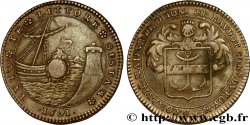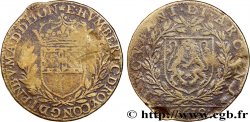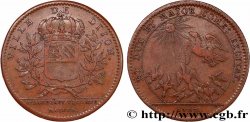E-auction 221-145984 - fjt_059459 - DIJON (MAYORS OF ... and miscellaneous) Marc-Antoine Millotet 1651
You must signin and be an approved bidder to bid, LOGIN TO BID. Accounts are subject to approval and the approval process takes place within 48 hours. Do not wait until the day a sale closes to register. Clicking on « bid » constitutes acceptance of the terms of use of cgb.fr private e-auctions.
Bids must be placed in whole Euro amounts only. The sale will start closing at the time stated on the item description; any bids received at the site after the closing time will not be executed. Transmission times may vary and bids could be rejected if you wait until the last second. For further information ckeck the E-auctions F.A.Q.
NO BUYER'S FEE.
NO BUYER'S FEE.
| Estimate : | 68 € |
| Price : | 20 € |
| Maximum bid : | 34 € |
| End of the sale : | 10 July 2017 18:08:00 |
| bidders : | 4 bidders |
Type : Marc-Antoine Millotet
Date: 1651
Metal : brass
Diameter : 27,5 mm
Orientation dies : 6 h.
Edge : lisse
Rarity : R1
Coments on the condition:
Flan particulièrement lourd
Catalogue references :
Obverse
Obverse legend : MARC. ANT. MILLOTET. CON. DEST. ADV. GEN. V. M. D. DIION *.
Obverse description : Armes de Dijon dans une couronne de laurier.
Reverse
Reverse legend : SCOPVLVS. PYRATARVM. 1651. (FLEURON).
Reverse description : Marc-Antoine Millotet debout sur un rocher au milieu des flots contre lesquels se brisent des vaisseaux chargés d’hommes.
Commentary
Marc-Antoine Millotet, premier avocat général au Parlement, fut élu maire le 21 juin 1650. Il porte d’azur au sautoir d’or accompagné en chef d’une croix raccourcie d’argent. *
Il raconte :
Lorsque j'entrai dans la magistrature, j'ôtai tous les moyens de prendre, outre que j'avais poursuivi force partisans, dont j'en avais fait pendre en effigie pour avoir falsifié les rôles du conseil. C'est pourquoi mes premiers jetons portaient cette devise: Scopulus piratorum; car d'un côté c'étaient les armes de la ville et mon nom qui les entourait, et de l'autre j'étais représenté sur un rocher au milieu des flots contre lequel se brisaient des vaisseaux chargés d'hommes. J'avais l'épée en une main et le bouclier dans l'autre où mes armes étaient gravées, et autour du jeton était ma devise pareille à celle de Pompée qui, après la défaite des Pirates, fut ainsi surnommé, comme il se voit dans Pétronne". Extrait d'un manuscrit intitulé "Mémoires servant à l'histoire des choses qui se sont passées en Bourgogne pendant la Ire et la 2e guerre civile en 1650, au tems de la détention des princes et depuis leur liberté, par M.A. Millotet. Dans la salle de l'ancien hôtel de ville, une inscription célèbre l'activité de M.A. Millotet: "Marc-Antoine Millotet, maire, par sa courageuse fermeté, maintint, en 1648, à Dijon, l'autorité du Roi pendant les guerres de la Fronde"
Les maires de Dijon
Dès l’époque de la naissance de la féodalité, la ville de Dijon possédait un maire et en général vingt magistrats municipaux, ou échevins. Ces magistrats sont confirmés en 1187, lorsqu’une charte de commune est accordée par le duc Hugues III. En 1192, pour la première fois, le maire dijonnais est élu.
A la fin du XIIIe siècle, ce maire prend le titre de vicomte maïeur, confirmé en 1477-1479 par Louis XI, qu’il gardera jusqu’en 1789. Depuis la fin du XVe siècle (1491), la charge de vicomte maïeur est anoblissante ainsi que celle d’échevin à compter du XVIe siècle. Le vicomte maïeur avait le droit de haute, moyenne et basse justice, le droit de scel et de visite. Les clefs de la ville lui sont confiées et il dirige les archers ainsi que les compagnies des sept quartiers, cette fonction militaire étant importante jusqu’au XVIIe siècle.
Fonction élective, le vicomte maïeur est élu par les habitants, ni mendiants, ni étrangers, qui payent la taille, en général la veille de la Saint-Jean. Cette élection a lieu sur le parvis de l'église saint Philibert. A partir de 1669, il est permis au maire de porter "une robe longue de satin plein, de couleur violet, doublée de satin rouge cramoisi, comme le prévôt des marchands de Lyon, avec chaperon de même étoffe et couleur bordée d’hermine" afin de se distinguer des habitants.
En 1692, la fonction de vicomte maïeur est transformée en office héréditaire tandis que l’élection n’est plus alors qu’une confirmation du choix royal fait par le gouverneur au nom du roi.
Voir leur liste complète à http://fr.wikipedia.org/wiki/Liste_des_maires_de_Dijon.
Marc-Antoine Millotet, first attorney general in Parliament, was elected mayor on June 21, 1650. He wears azure with a gold saltire accompanied in chief by a shortened silver cross. * He says: When I entered the magistracy, I removed all means of taking, besides having pursued many partisans, some of whom I had hanged in effigy for having falsified the council roles. That is why my first tokens bore this motto: Scopulus piratorum; for on one side were the arms of the city and my name surrounding them, and on the other I was represented on a rock in the middle of the waves against which ships laden with men were breaking.. I had the sword in one hand and the shield in the other on which my arms were engraved, and around the token was my motto like that of Pompey who, after the defeat of the Pirates, was thus nicknamed, as it is seen in Petronas\\\". Excerpt from a manuscript entitled \\\"Memoirs serving the history of things that happened in Burgundy during the 1st and 2nd civil wars in 1650, at the time of the detention of the princes and since their freedom, by M. HAS. Millotet. In the hall of the old town hall, an inscription celebrates the activity of M. HAS. Millotet: \\\"Marc-Antoine Millotet, mayor, through his courageous firmness, maintained, in 1648, in Dijon, the authority of the King during the wars of the Fronde\\\" The mayors of Dijon From the time of the birth of feudalism, the city of Dijon had a mayor and generally twenty municipal magistrates, or aldermen. These magistrates were confirmed in 1187, when a municipal charter was granted by Duke Hugh III.. In 1192, for the first time, the mayor of Dijon was elected.
At the end of the 13th century, this mayor took the title of viscount mayor, confirmed in 1477-1479 by Louis XI, which he kept until 1789. Since the end of the 15th century (1491), the position of viscount mayor has been ennobling, as has that of alderman since the 16th century.. The Viscount Mayor had the right of high, middle and low justice, the right of seal and visitation. The keys to the city were entrusted to him and he commanded the archers as well as the companies of the seven districts, this military function being important until the 17th century..
An elective function, the Viscount Mayor is elected by the inhabitants, neither beggars nor foreigners, who pay the tax, generally on the eve of Saint John.. This election takes place on the forecourt of the Saint Philibert church. From 1669, the mayor was allowed to wear \\\"a long robe of full satin, purple in color, lined with crimson red satin, like the provost of the merchants of Lyon, with a chaperon of the same fabric and color edged with ermine\\\" in order to distinguish himself from the inhabitants..
In 1692, the function of Viscount Mayor was transformed into a hereditary office while the election was then only a confirmation of the royal choice made by the governor in the name of the king..
See their full list at http://fr. Wikipedia. org/wiki/List_of_mayors_of_Dijon
Il raconte :
Lorsque j'entrai dans la magistrature, j'ôtai tous les moyens de prendre, outre que j'avais poursuivi force partisans, dont j'en avais fait pendre en effigie pour avoir falsifié les rôles du conseil. C'est pourquoi mes premiers jetons portaient cette devise: Scopulus piratorum; car d'un côté c'étaient les armes de la ville et mon nom qui les entourait, et de l'autre j'étais représenté sur un rocher au milieu des flots contre lequel se brisaient des vaisseaux chargés d'hommes. J'avais l'épée en une main et le bouclier dans l'autre où mes armes étaient gravées, et autour du jeton était ma devise pareille à celle de Pompée qui, après la défaite des Pirates, fut ainsi surnommé, comme il se voit dans Pétronne". Extrait d'un manuscrit intitulé "Mémoires servant à l'histoire des choses qui se sont passées en Bourgogne pendant la Ire et la 2e guerre civile en 1650, au tems de la détention des princes et depuis leur liberté, par M.A. Millotet. Dans la salle de l'ancien hôtel de ville, une inscription célèbre l'activité de M.A. Millotet: "Marc-Antoine Millotet, maire, par sa courageuse fermeté, maintint, en 1648, à Dijon, l'autorité du Roi pendant les guerres de la Fronde"
Les maires de Dijon
Dès l’époque de la naissance de la féodalité, la ville de Dijon possédait un maire et en général vingt magistrats municipaux, ou échevins. Ces magistrats sont confirmés en 1187, lorsqu’une charte de commune est accordée par le duc Hugues III. En 1192, pour la première fois, le maire dijonnais est élu.
A la fin du XIIIe siècle, ce maire prend le titre de vicomte maïeur, confirmé en 1477-1479 par Louis XI, qu’il gardera jusqu’en 1789. Depuis la fin du XVe siècle (1491), la charge de vicomte maïeur est anoblissante ainsi que celle d’échevin à compter du XVIe siècle. Le vicomte maïeur avait le droit de haute, moyenne et basse justice, le droit de scel et de visite. Les clefs de la ville lui sont confiées et il dirige les archers ainsi que les compagnies des sept quartiers, cette fonction militaire étant importante jusqu’au XVIIe siècle.
Fonction élective, le vicomte maïeur est élu par les habitants, ni mendiants, ni étrangers, qui payent la taille, en général la veille de la Saint-Jean. Cette élection a lieu sur le parvis de l'église saint Philibert. A partir de 1669, il est permis au maire de porter "une robe longue de satin plein, de couleur violet, doublée de satin rouge cramoisi, comme le prévôt des marchands de Lyon, avec chaperon de même étoffe et couleur bordée d’hermine" afin de se distinguer des habitants.
En 1692, la fonction de vicomte maïeur est transformée en office héréditaire tandis que l’élection n’est plus alors qu’une confirmation du choix royal fait par le gouverneur au nom du roi.
Voir leur liste complète à http://fr.wikipedia.org/wiki/Liste_des_maires_de_Dijon.
Marc-Antoine Millotet, first attorney general in Parliament, was elected mayor on June 21, 1650. He wears azure with a gold saltire accompanied in chief by a shortened silver cross. * He says: When I entered the magistracy, I removed all means of taking, besides having pursued many partisans, some of whom I had hanged in effigy for having falsified the council roles. That is why my first tokens bore this motto: Scopulus piratorum; for on one side were the arms of the city and my name surrounding them, and on the other I was represented on a rock in the middle of the waves against which ships laden with men were breaking.. I had the sword in one hand and the shield in the other on which my arms were engraved, and around the token was my motto like that of Pompey who, after the defeat of the Pirates, was thus nicknamed, as it is seen in Petronas\\\". Excerpt from a manuscript entitled \\\"Memoirs serving the history of things that happened in Burgundy during the 1st and 2nd civil wars in 1650, at the time of the detention of the princes and since their freedom, by M. HAS. Millotet. In the hall of the old town hall, an inscription celebrates the activity of M. HAS. Millotet: \\\"Marc-Antoine Millotet, mayor, through his courageous firmness, maintained, in 1648, in Dijon, the authority of the King during the wars of the Fronde\\\" The mayors of Dijon From the time of the birth of feudalism, the city of Dijon had a mayor and generally twenty municipal magistrates, or aldermen. These magistrates were confirmed in 1187, when a municipal charter was granted by Duke Hugh III.. In 1192, for the first time, the mayor of Dijon was elected.
At the end of the 13th century, this mayor took the title of viscount mayor, confirmed in 1477-1479 by Louis XI, which he kept until 1789. Since the end of the 15th century (1491), the position of viscount mayor has been ennobling, as has that of alderman since the 16th century.. The Viscount Mayor had the right of high, middle and low justice, the right of seal and visitation. The keys to the city were entrusted to him and he commanded the archers as well as the companies of the seven districts, this military function being important until the 17th century..
An elective function, the Viscount Mayor is elected by the inhabitants, neither beggars nor foreigners, who pay the tax, generally on the eve of Saint John.. This election takes place on the forecourt of the Saint Philibert church. From 1669, the mayor was allowed to wear \\\"a long robe of full satin, purple in color, lined with crimson red satin, like the provost of the merchants of Lyon, with a chaperon of the same fabric and color edged with ermine\\\" in order to distinguish himself from the inhabitants..
In 1692, the function of Viscount Mayor was transformed into a hereditary office while the election was then only a confirmation of the royal choice made by the governor in the name of the king..
See their full list at http://fr. Wikipedia. org/wiki/List_of_mayors_of_Dijon








 Report a mistake
Report a mistake Print the page
Print the page Share my selection
Share my selection Ask a question
Ask a question Consign / sell
Consign / sell
 Full data
Full data









